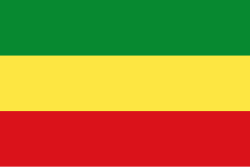

| Part of a series on |
| Pan-Africanism |
|---|
 |
Pan-African colours is a term that may refer to two different sets of colours:
Contents
- Green-yellow-red
- Red-black-green
- Flags with Pan-African colours
- Current country flags with the Pan-African symbolism
- Non-national flags
- Former flags with pan-African colours
- See also
- References
- Green, yellow and red, the colours of the flag of Ethiopia, have come to represent the pan-Africanist ideology due to the country's history of having avoided being taken over by a colonial power. Numerous African countries have adopted the colours into their national flags, and they are similarly used as a symbol by many Pan-African organisations and the Rastafari movement.
- Red, black, and green, first introduced by Marcus Garvey in 1920, have also come to represent Pan-Africanism, and are shown on the pan-African flag. These colours have also been incorporated on national flags, and they have sometimes been used to represent black nationalism rather than Pan-Africanism. [1]



























